The type of DNA test used by AncestryDNA is called an autosomal DNA test. It examines your nuclear DNA, which is passed down to you from your parents, who got it from their parents, from their parents, etc… so your DNA is made up of DNA from your ancestors.
You order your AncestryDNA® kit online, it arrives in the mail, you collect your saliva sample and post it back to AncestryDNA. (Australian customers can simply drop the supplied reply-paid satchel into any red Australia Post box in Australia).
DNA kits are sent back to the laboratory in the USA for processing. A special chip reads around 670,000 markers from your autosomal DNA and creates a digital data file. Your DNA data is compared with the DNA data of millions of other people who have tested at AncestryDNA and a list of people who share DNA with you will be shown in your online results.
Your closest DNA matches – ie. your biological relatives, will be shown at the top of the list. As more people test, you will see new matches appearing in your results. If you have already researched your family history, you may recognise some of the closer relatives listed in your DNA matches. If you don’t know your origins at all, the family trees of your closest matches will be where you can start to try to work out how and where you connect.
Anyone can do an AncestryDNA test, regardless of age or sex, and it can match you to relatives on all lines of your pedigree. A parent or guardian can manage a DNA test on behalf of their minor child (read more).
If you still have older generations alive in your family – including but not limited to parents, grandparents, great grandparents, or aunts/uncles, great aunts/uncles – consider asking them to test their DNA too, as even though you may not understand the reasons why just now, their DNA results will be invaluable to your family history research. You only inherit half of each of your parents’ DNA, and they only inherited half of their parents’ DNA, so your DNA is effectively diluted by 50% each generation. Older generations will get much stronger and closer DNA matches than you will get.
Read more about Testing Family Members with AncestryDNA on Ancestry’s blog.
AncestryDNA® is usually the first test recommended for people with unknown parentage, as the huge database is very effective at helping to identify biological family. Thousands of adoptees, donor conceived individuals, foundlings, child migrants, war babies, and even some amnesiacs have had success. Many gamete donors and natural/relinquishing parents also test themselves in the hope of one day connecting with their offspring (or to enable direct contact with offspring rather than the offspring contacting other family members who might do a DNA test).
AncestryDNA tests are very accurate at detecting matches to immediate family and close relatives. The AncestryDNA database is worldwide, so relatives from other countries will also appear in your matches if they test.
Parents, children, siblings, half-siblings, grandparents, grandchildren, aunts, uncles nieces, nephews, first cousins, half cousins, second cousins, etc… all will show in your match list if they also do an AncestryDNA test.
The probability of matching cousins who have tested at the same company reduces as the connection gets further back, but it can detect matches to biological relatives on all lines back about 5 or 6 generations, more in some cases.
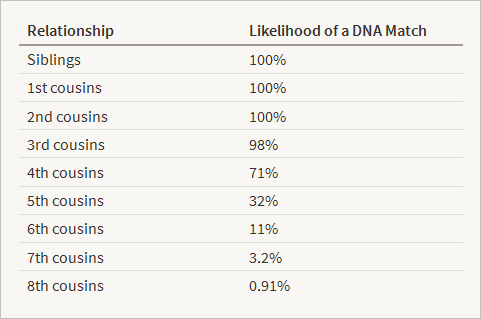
Test kits are purchased online from AncestryDNA®. Kits for Australian customers usually arrive in within 7-14 days, if not sooner.
The DNA kit contains a saliva collection tube, a screw-on cap filled with preservative liquid, a plastic bag, a return-addressed reply-paid packaging box and an instruction sheet.
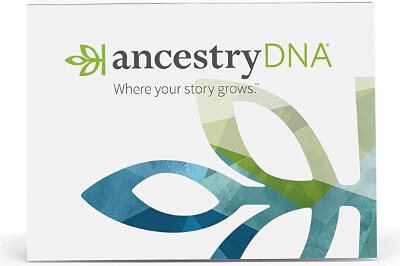
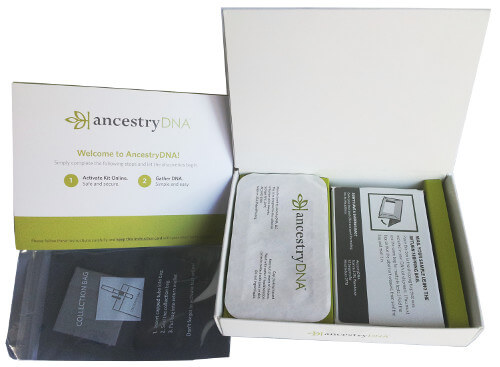
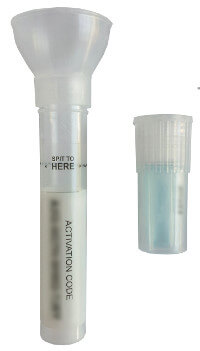

Follow the instruction card to activate your kit online. That just means that you will be asked to register a free Ancestry account (if you don’t already have one) and enter the unique barcode from the saliva collection tube into the account. That process links your saliva sample to you so you can view the results online when they are ready. (If you forget to activate your kit before posting it back, your unique activation code is also conveniently printed on the back of the instruction card… so keep the packaging until you have activated the kit).
Next you just need to spit a bit of saliva into the collection tube (read and follow the instructions!), replace the funnel with the liquid-filled cap, seal it into the plastic collection bag, seal that into the little return box, then put the box into any red Australia Post box (if you have an older kit that includes a prepaid return-addressed Australia Post satchel, use that).
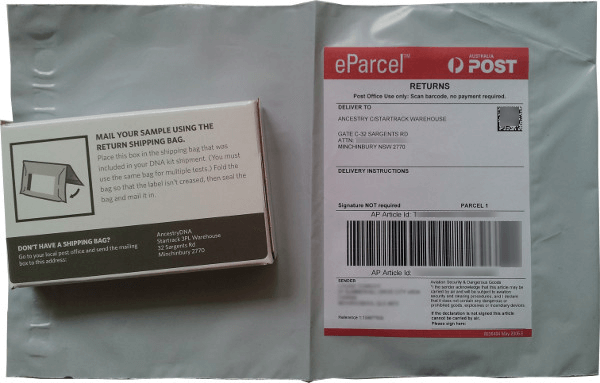
The regular price for AncestryDNA kits varies from country to country. You order from the Ancestry website for the country you live in. Shipping costs, methods and routes vary by country. Follow the instructions in your particular kit.
Regular prices for each country are shown below; the adverts show current sales, or click through to Ancestry’s website to check.
Ancestry occasionally has sales – which will appear in the relevant countries’ adverts above if a sale is current, but also check current DNA test prices and sales.
I recommend that everyone tests at AncestryDNA, usually first, as the match success rate is very high due to the very large database of testers. To compare features with the other available autosomal DNA tests, read Which DNA testing company should I use?
Allow two to three months, as you need to allow a week or two to receive the kit, a couple more weeks for it to be received back in the laboratory in the US, plus a few weeks of processing time.
Ancestry says to allow 6-8 weeks, but often results are ready quicker – sometimes in just a few weeks. There may be slight delays after big sales, but that usually means more people are testing so everyone including you will end up with more DNA matches!

Yes, you can order as many AncestryDNA kits as you like and have them sent to you.
It is not until they are activated that a name or account is required to be linked to them, so you can order as many kits as you like from your own Ancestry account, stock up on kits when they are on sale, and work out who will use them later.
You can also order a kit and have it delivered to someone else’s address, for example as a gift, or if you are paying for a relative or friend to test.
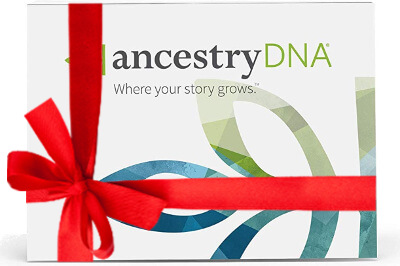
Ancestry will email you to notify you when your results are ready. You can also check on the progress from your Ancestry account.
To check your DNA results at any time, sign-in to your Ancestry account and click on the DNA tab in the menu bar at the top:

Your DNA results are divided into three sections (refer to image below):
The DNA page also includes a link to access your DNA Settings (to link your DNA to your tree, to share your results, download your DNA data, select your display name, etc), a link to Activate a new test, a drop-down list to view other tests that have been shared with you (yes, you can easily share your results with family and friends!). Also note that there are lots of little ‘?‘ help icons around the page, so you can click them for help on each section.
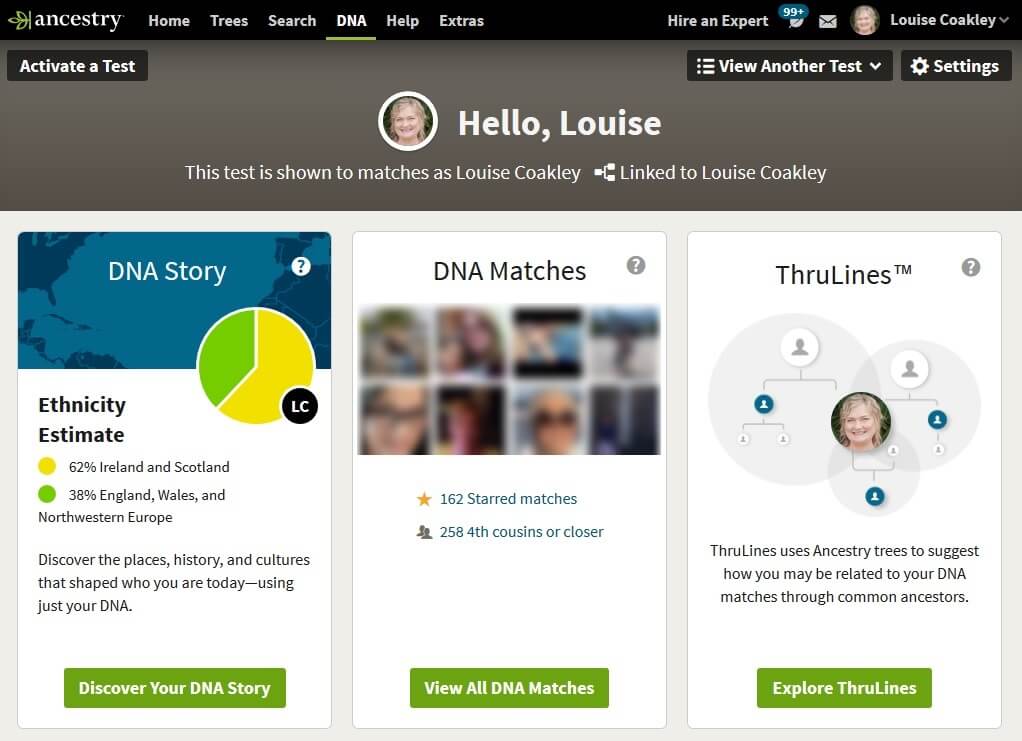
Click on Discover Your DNA Story to view your ancestral/biogeographical breakdown (ethnicity estimate). The DNA Story page is interactive, so you can move/drag it, scroll it, zoom in and out, click on the map, click on the regions and sub-regions in the side-panel to open up historical and match information for each region. And there are buttons to print it, share it, get more help, open your family tree, or go back to your main DNA results.
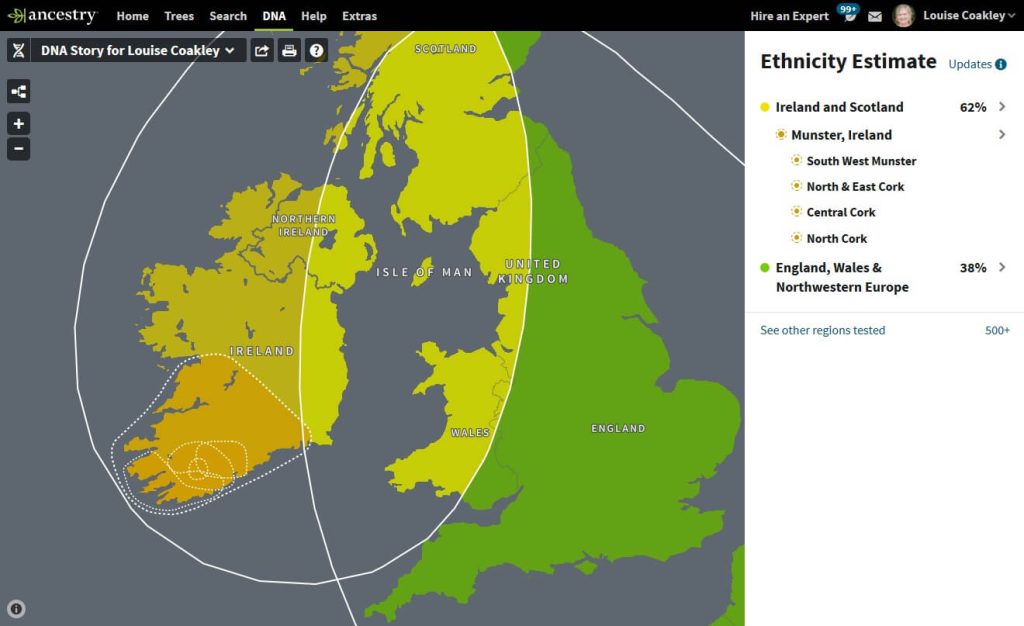
If you click on one of the genetic communities (sub-regions) in the right sidebar shown above, the map will zoom in, a timeline and corresponding content will appear, and you can scroll down and explore the historical, match and timeline information, or explore it by interacting with the map. There are so many links to click and sections to explore.
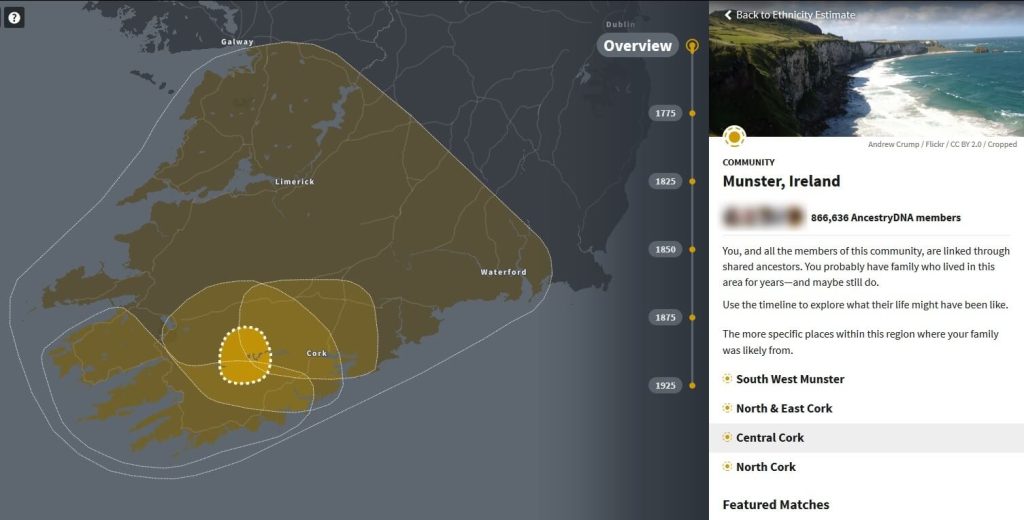
From your main DNA page, if you click on the middle section – DNA Matches – you’ll see your list of biological relatives … people with whom you share some DNA.
The closest matches will be at the top of the list.

You can click on any DNA match’s name, profile image or tree link to open a match detail page for that match. This includes a link to their profile (via their hyperlinked name or username), the amount of shared DNA, a Message button so you can correspond, a place to add or edit notes, view their family tree if they have one linked to their DNA (and if you have a subscription to allow you to view trees), view their Ethnicity, view any matches you both share, you can access extra Tools, see if there are any Common Ancestor Hints (which will also be highlighted in the tree). You can expand the tree, scroll down to view shared surnames, and compare yours and your match’s ancestral locations on an interactive map.
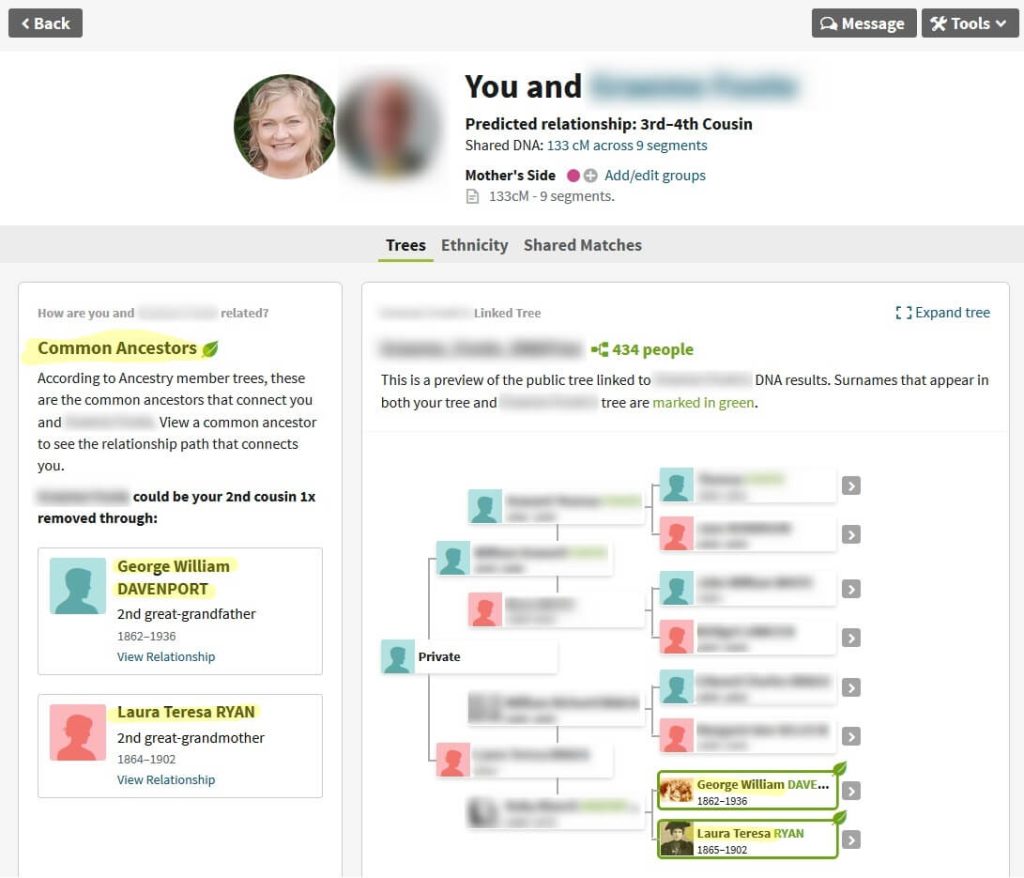
Below is an example of ThruLines, the feature that provides visual suggestions of how your DNA matches might relate to you, if you both have a family tree that has matching ancestral names. Even if your tree or their tree doesn’t go back far enough or doesn’t connect directly, Ancestry’s algorithms look at historical records and other family trees to see if it can suggest connections to your ancestors or their siblings. It is a very clever tool!
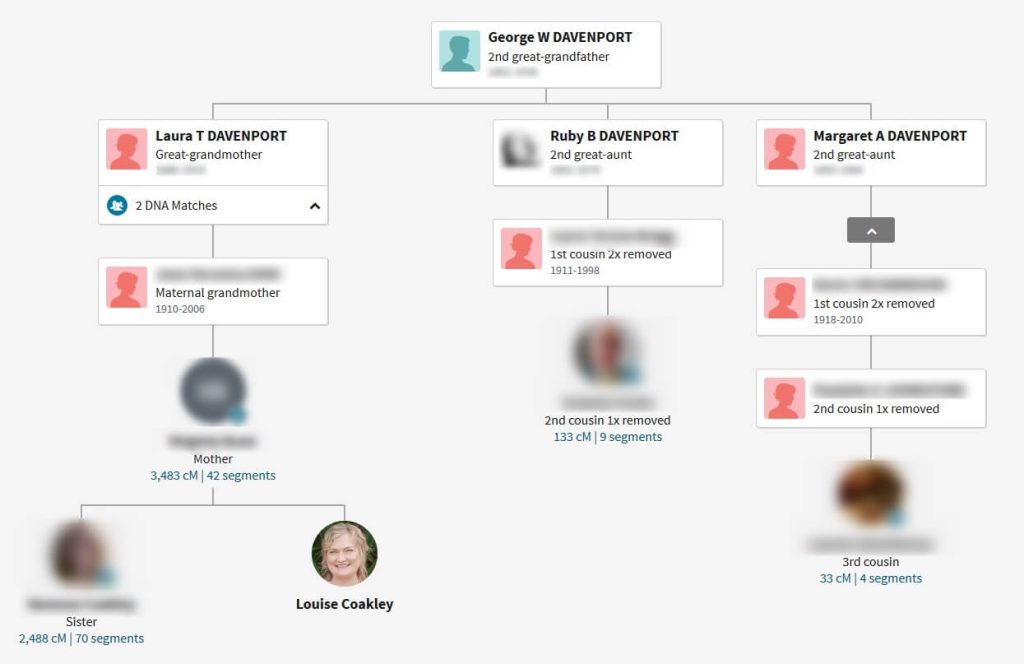
"Wow! All this from a little bit of spit... there's so much more than just an ethnicity estimate! I can't wait to see what my DNA reveals!"
Yes, you can manage DNA accounts for others, as long as they grant you permission.
Each tester is the ‘Owner’ of their own DNA, and must register a free Ancestry account (if they don’t already have one) to activate their own DNA kit and to receive their results. Once a DNA kit has been activated in an Owner‘s account, the Owner can transfer the administration of it to a Manager if they like. A Manager can then look after the account, including receiving and responding to messages.
Many elderly or non-computer-literate testers prefer to ask someone else to manage their DNA accounts. Owners can also share their DNA results with any other family, friends, DNA matches, helpers, etc, either just as Viewers, or as Collaborators (who can help, add notes etc). An Owner can downgrade or revoke sharing access at any time.
Ancestry’s DNA results sharing system is flexible and practical, and it enables helpers to access results without needing to know the tester’s login information.
A parent or guardian can manage a DNA account for their minor child.
If you have already tested your DNA at AncestryDNA, you can transfer your raw DNA data file to MyHeritage DNA, Family Tree DNA, Living DNA and GEDmatch (for free) to receive more DNA matches and use their different features and analysis tools.
Read How to Download your Raw DNA Data for instructions on downloading and uploading/transferring your DNA data elsewhere.